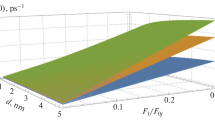Scattering on an ultralow potential in an armchair graphene nanoribbon is studied. Using the continuous Dirac model and including a couple of artificial waves in the scattering process, described by an augmented scattering matrix, a condition is derived for the existence of a trapped mode. Threshold energies, where the multiplicity of the continuous spectrum changes, are considered, and it is shown that a trapped mode may appear for energies slightly less than a threshold and its multiplicity does not exceed one. For energies that are higher than a threshold, there are no trapped modes, provided that the potential is sufficiently small.
Similar content being viewed by others
References
T. Ando and T. Nakanishi, “Impurity scattering in carbon nanotubes – absence of back scattering,” J. Phys. Soc. Jpn., 67, 1704–1713 (1998).
L. Brey and H. A. Fertig, “Electronic states of graphene nanoribbons studied with the Dirac equation,” Phys. Rev., B 73, 235411 (2006).
A. H. Castro Neto, F. Guinea, N. M. R. Peres, K. S. Novoselov, and A. K. Geim, “The electronic properties of graphene,” Rev. Mod. Phys., 81, 109 (2009).
Q. Chen, L. Ma, and J. Wang, “Making graphene nanoribbons: a theoretical exploration,” WIREs Comput. Mol. Sci., 6, No. 3, 243–254 (2016).
I. V. Kamotskii and S. A. Nazarov “An augmented scattering matrix and an exponentially decreasing solution of the elliptic boundary-value problem in a domain with cylindrical outlets,” Zap. Nauchn. Semin. POMI, 264, 66–82 (2000).
V. Kozlov and V. Maz’ya, Differential Equations with Operator Coefficients with Applications to Boundary Value Problems for Partial Differential Equations, Springer Monographs in Mathematics, Springer-Verlag, Berlin (1999).
V. A. Kozlov, S. A. Nazarov, and A. Orlof, “Trapped modes in zigzag graphene nanoribbons,” Z. Angew. Math. Phys., 68, No. 4, Art. 78, 31 (2017).
L. I. Mandelstam, Lectures on Optics, Relativity, and Quantum Mechanics. 2, AN SSSR, Moscow (1947).
P. Marconcini aand M. Macucci, “The k ⋅ p method and its application to graphene, carbon nanotubes and graphene nanoribbons: the Dirac equation,” La Rivista del Nuovo Cimento, 45, No. 8–9, 489–584 (2011).
S. A. Nazarov, “Asymptotic expansions of eigenvalues in the continuous spectrum of a regularly perturbated quantum waveguide,” Theoretical and Mathematical Physics, 167, No. 2, 239–262 (2011).
S. A. Nazarov, “Enforced stability of an eigenvalue in the continuous spectrum of a waveguide with an obstacle,” Zh. Vychisl. Mat. Mat. Fiz., 52, No. 3, 521–538 (2012).
S. A. Nazarov, “Enforced stability of a simple eigenvalue in the continuous spectrum of a waveguide,” Funct. Anal. Appl., 47, No. 3, 195–209 (2013).
S. A. Nazarov, “Umov-Mandelstam radiation conditions in elastic periodic waveguides,” SB MATH, 205, No. 7, 953–982 (2014).
S. A. Nazarov and B. A. Plamenevsky, Elliptic Problems in Domains with Piecewise Smooth Boundaries, Walter de Gruyter, Berlin, New York (1994).
K. S. Novoselov, A. K. Geim, S. V. Morozov, D. Jiang, Y. Zhang, S. V. Dubonos, I. V. Grigorieva, and A. A. Firsov, “Electric field effect in atomically thin carbon films,” Science, 306, 666 (2004).
I. I. Vorovich and V. A. Babeshko, Dynamical mixed Problems of Elasticity Theory for Nonclassical Domains [in Russian], Nauka, Moscow (1979).
Author information
Authors and Affiliations
Corresponding author
Additional information
Published in Zapiski Nauchnykh Seminarov POMI, Vol. 483, 2019, pp. 85–115.
Rights and permissions
About this article
Cite this article
Kozlov, V.A., Nazarov, S.A. & Orlof, A. Trapped Modes in Armchair Graphene Nanoribbons. J Math Sci 252, 624–645 (2021). https://doi.org/10.1007/s10958-021-05186-9
Received:
Published:
Issue Date:
DOI: https://doi.org/10.1007/s10958-021-05186-9



